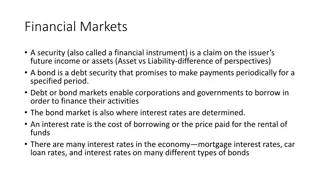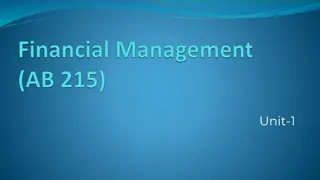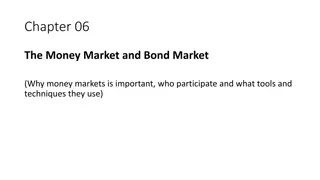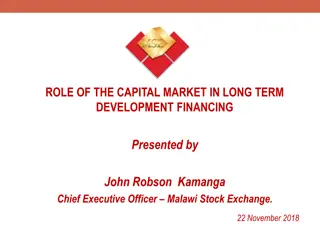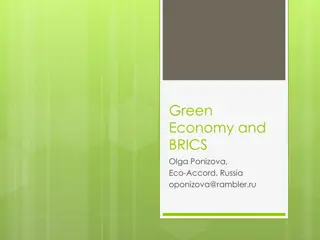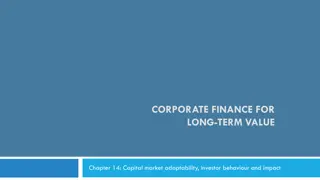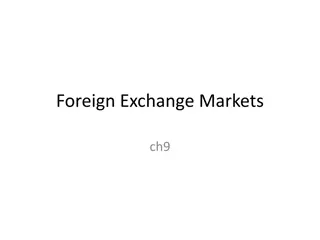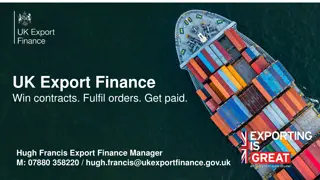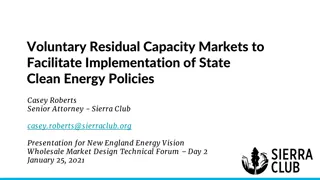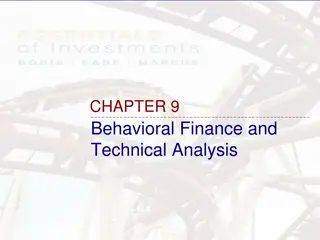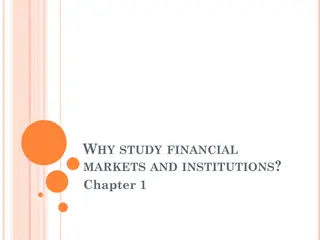Understanding Global Markets and Finance in Today's Economy
Explore the impacts of globalization on world economies, focusing on trade and global finance. Learn about trade imbalances, resistance to globalization, and the evolving world trading system. Dive into topics like history of trade relations, free trade debates, international finance, currency roles, and US trade relations over time.
Download Presentation

Please find below an Image/Link to download the presentation.
The content on the website is provided AS IS for your information and personal use only. It may not be sold, licensed, or shared on other websites without obtaining consent from the author. Download presentation by click this link. If you encounter any issues during the download, it is possible that the publisher has removed the file from their server.
E N D
Presentation Transcript
The International Economy: Global Global Markets and Global Markets and Global Finance Finance Mark S. LeClair Fairfield University
Description: Globalization has dramatically altered the economies of both industrialized and developing nations. This course will examine the impacts of the internationalization of the world economy, focusing both on trade and global finance. The 2016 election highlights some of the resistance to the impacts of globalization within the U.S. The stalled World Trade Organization talks are another indicator of pushback against the rapid march towards free and open trade. Global trade imbalances (trade deficits) have now created circumstances in which the global financial structure is under stress, which may lead to significant changes in how trade is financed, which currencies are used, and which countries dominate the world trading system.
Go to www.faculty.fairfield.edu/mleclair Look for link marked Lifelong Learning at top
Topics for Six Weeks Topics for Six Weeks History of Trade Relations From Protectionism to Globalism -Regionalism (Free Trade Areas) From the EU to NAFTA -The Free Trade Debate Why is Free Trade now Controversial -International Finance The Bretton Woods System and Post-War Economic Relations
-The Currency Problem The Role of the dollar, euro, and other reserve currencies -The Developing Nations in the World Financial System
Trade Relations of the U.S. Trade Relations of the U.S. From Protectionism to Globalism Protectionism to Globalism Concept of Free Trade is Recent (Post WW2) Initially, Tariffs were a source of revenue funded the Federal Government Fought War of 1812 on tariff revenues Tariffs began slow drift downwards from 70% average to less than 60% by time of Civil War Major issue between North and South North wanted high tariffs, South wanted cheap goods From
True tariff reductions finally occur in the 1920s Average tariff rate drops to 15%
Onset of Great Depression Onset of Great Depression U.S. pursued Beggar Thy Neighbor policy Smoot-Hawley Tariffs raised average tariff to 60% Europe Responded in kind international trade dried up Major cause of Great Depression As Depression is winding down (and war starting) U.S. tentatively begins negotiating reduced tariffs (bilateralism) Process is slow, destined to take decades
Instead, U.S. and Allies Move to Multilateralism . 1947 General Agreement on Tariffs and Trade (GATT System) Was supposed to become part of International Trade Organization, but never supported in Congress Under GATT, tariff cuts become universal Uniformity of Treatment Even for nations that were not cutting their tariffs Result was rapid and universal unwinding of tariffs
Most important notion of GATT was Most Favored Nation (MFN) status Every country (except enemies) received MFN status and therefor the lower tariffs At the moment, only Cuba and North Korea are w/out MFN status Although invaluable, this aspect of the GATT will turn out to be problematic later on
Work of GATT proceeded in Rounds Most important were: The 1947 Round, Kennedy Round, Tokyo Round, Uruguay Round Currently in the Doha Round, but is moribund During each Round, negotiators representing all members of the GATT would seek give and take on tariffs and other barriers
The Kennedy Round (1962 The Kennedy Round (1962- -65) 65) U.S. pushed for extensive tariff cuts Fear that the now-forming European Economic Community (EEC) would destroy the GATT EEC was an open violation of the tenets of the GATT large tariff cuts would help undermine its advantages Kennedy Round secured very large cuts by all participants, and also clarified how nations deal with dumping From U.S. perspective, undercut EEC enough to prevent it from destroying the GATT
The Tokyo Round.. The Tokyo Round .. Worked on: Nontariff barriers Industrial Standards Hot plate story Sanitary standards Intellectual Property Rights protection A major fail U.S. innovations routinely stolen
Uruguay Round (1994) Addressed major problem with structure of GATT system MFN status allowed developing nations to sit back and take tariff cuts without cutting their own trade barriers Uruguay Round forced their involvement Although tariff rates remain high in developing world, at least they were cut somewhat Uruguay Round also created the WTO
World Trade Organization World Trade Organization
Much more powerful than GATT Particularly trade dispute powers U.S. was immediately sued over dolphin-safe tuna and lost the case Environmentalists have been unhappy with the GATT/WTO for some time, as have labor organizations Helped produce the riots in 1999 in Seattle
Finally, the Doha Round (Qatar) The Development Round Focus was on expanding the trade of the developing nations Key to success reduction of agricultural tariffs in the U.S. and Europe But, tariffs are a result of agricultural subsidies cannot remove them without removing price manipulation in markets For U.S., peanuts, cotton, milk, sugar are major problems (with cotton with have a quota)
Failure to solve this issue has stalled round (nations are in the 16thyear of negotiations) Other problem is diminishing returns Average tariffs rates for the U.S., the EU and Japan are about 2% Hard to gather 150 nations together to argue about such low tariff barriers Is the WTO permanently stalled?
Remaining Issues may be Politically Unsolvable U.S. tariffs on cotton, sugar, etc. are politically embedded No way to eliminate Yet, these are exactly the places developing nations in Africa could compete (Mali is a major producer of cotton) U.S. uses its trade preference program to help out some developing nations But, protection of industry still primary goal
WTO Will Continue to Act as Trade Dispute Body Rules on complaints by nations about unfair trade practices e.g. President Bush s imposition of protective tariffs on steel European imposition of tariffs on U.S. agriculture in the 1980s WTO found both practices illegal and enabled the offended nations to impose retaliatory tariffs As in most cases, original tariffs removed before sanctions imposed
Week 2 - Regionalism In the news during campaign with discussion of Trans- Pacific Partnership (TPP) Regionalism refers to agreements that produce free trade between member states, sometimes at the expense of non-members Began with Treaty of Rome in 1957 Regionalism a major threat to the GATT at the time
Expansion of Free Trade Agreements Central American Common Market (1960) Latin American Free Trade Area (later Latin American Integration Association) Argentina-Brazil FTA NAFTA (1994) Mercosur (1994) Association of Southeast Asian Nations (ASEAN) Caricom (Caribbean Community)
Problem FTAs are at Odds with GATT System GATT/WTO promise that all nations get equal treatment Not possible when some nations are members of an FTA Had to rewrite GATT rules to allow for E.E.C. Article XXIV permits free trade areas as long as they are trade- creating , not trade-diverting That is, they increase overall trade rather than simply transferring it from a nation that is outside the FTA to one inside
Would argue that the EU has been trade-diverting at times, but it has been ignored Particularly true of the later entrants to the Union Piecemeal formation has made measurement difficult: 1964-8 original five members 1973 UK, Ireland and Denmark 1981 Greece 1986 Spain and Portugal Etc.
Now 28 members (soon to be 27) with deep economic ties, although some deeper than others
Stages of Integration Can identify 5 distinct steps in formation of a union such as the EU Free Trade Area All barriers to trade dropped Customs Union Adoption of common external tariffs Common Market Add labor and capital mobility to the above (labor mobility may be a key sticking point) Common Currency (euro) adopted by 17 countries Political Union European Parliament, European Central Bank, etc.
EU has proceeded far beyond all other Unions But, at each stage, there is a loss of autonomy Fractures are now appearing in rush to create a United States of Europe Failure of 9 countries to adopt the euro Upcoming exit of the UK Failure of the French to pass EU Constitution in 2005 Reversal of rule on labor mobility after admission of Eastern European nations
Other Integration Movements Other Integration Movements Central American Common Market Caribbean Community (CARICOM) Latin American Integration Association (LAIA) Mercosur (Southern Market) Association of Southeast Asian Nations (ASEAN) North American Free Trade Agreement (NAFTA) Now expanded in Latin America, sort of
Most are Free Trade Areas Most are Free Trade Areas Going back to five stages of integration Second stage is Customs Union (common external tariffs) NAFTA never got to this stage Certainly no interest in free labor mobility (stage 3) Most integration movements have done little except eliminate tariffs Mercosur in particular was supposed to be the EU of Latin America Fell apart in recession of 2001
Problem.Regional Integration is the only game in town at moment hasn t worked well Reinvigorating the GATT/WTO would take a major breakthrough Unlikely at present So stuck with regional trading agreements, which are becoming unpopular (TPP)
History of NAFTA Signed in 1994 under President Bill Clinton Expanded U.S.-Canada Free Trade Agreement to Mexico Eliminated all trade barriers (with some exceptions) Included environmental standards to prevent all industry from moving to Mexico Allowed for transnational shipping (a sticking point) DID NOT seek common external tariffs
Somewhat Misleading 1994 is both NAFTA s first year and the year of the Tequila Crisis Mexican government went into technical default U.S. helped bail out through Brady Plan (Debt for Equity Swaps) At start of crisis, 6 pesos to the dollar Quickly dropped to 9 to the dollar Mexican goods became much cheaper (Now 18 to the dollar) this might be an important factor in trade deficit
However, one can see why anti-trade sentiment resonated in last election Jobs heading south, with products re-exported to U.S. Some remaining tariffs (Canada tariffs U.S. dairy products) are maddening
Other Nations that have Free Trade Agreements with U.S. Chile Colombia Peru Was supposed to be part of FTAA 34 nations stretching from Argentina to Canada Politics went left in Brazil, Argentina, Venezuela and deal fell apart Repeated story of FTAs always seem to disappoint
Proposed Membership Australia Canada Japan Malaysia Mexico Peru United States Vietnam Chile Brunei Singapore New Zealand
Why Controversial. Experience with NAFTA (ballooning trade deficit) made some leery Incorporation of developing nations (e.g. Vietnam and Malaysia) unsettling to opponents Although U.S. tariffs are very low, some labor-intensive goods still face significant tariffs Would have been dropped under TPP Probably little impact on entry of developed nations (tariffs already low, as noted)
Innovations in TPP that were Supposed to Matter Tight control on intellectual property theft But, had failed in the past Would have cut 18,000 tariffs Treated government entities with neutrality An issue for U.S. Hard to compete with government entities that have no downside risk Large number of environmental provisions (e.g. overfishing) NAFTA also contained these never fully enforced
Problem with FTAs in general for the U.S. mirrors that with the GATT/WTO The U.S. is the dominant producer of intellectual goods Abandoned much of our production of physical goods Theft is impossible to control Movies, software, drugs, etc. all get borrowed GATT/WTO rules on intellectual property are strident, but frequently unenforceable
In end, Regional Integration and the GATT/WTO Process are not Consistent With both stalled at present, hard to see how trade picture changes further Maybe hard work is done, and not much more can be achieved WTO remains active as a dispute body Only means of preventing re-imposition of trade barriers Recent very important ruling against Airbus Europe has illegally subsidized Airbus in its fight against Boeing
Week 3 Free Trade Debate Why is Free Trade now Controversial U.S. appears to be the international patsy in terms of free trade Have run trade deficits since 1983 Appear large and unsustainable, yet they continue Has led to loss of jobs in manufacturing Most Americans don t feel rise in jobs in other sectors has been dramatic enough to compensate
Major Cause Abandonment of Dollar Standard in 1973 When dollar was only reserve currency, could not run deficits Would flood the world with dollars and collapse the fixed rate system Economists had no experience with floating rates and free capital flows Misread impact
Presumed Versus Actual Outcomes Presumed: Trade deficit Outflow of dollars Drop in value of dollar U.S. Exports up and Imports down Actual: Trade deficit Outflow of Dollars Inflow of Capital from abroad No change in value of dollar
Strong Dollar Policy of Clinton Era Intended partly to encourage purchase of U.S. treasuries Also meant to help developing nations Ended up institutionalizing U.S. trade deficits Some hoped that strong euro would push down deficits, at least with Europe But, continuing euro-crises have devalued euro
Individual Sectors in U.S. Hit Very Hard Textiles, Clothing, Appliances, Electronics Chinese entry into WTO (1994) accelerated process Current deficit with China is $350 billion per year Other major problem used to be energy (oil) Fracking has ended that issue







